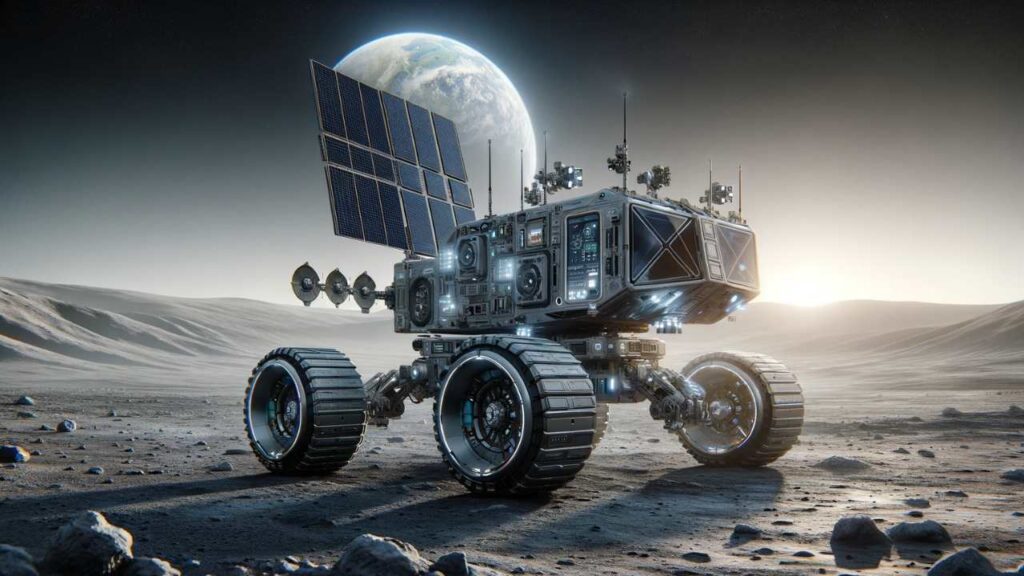NASA’s Terrain Vehicle- Explore the pivotal role of NASA’s Lunar Terrain Vehicle (LTV) in the Artemis missions, aimed at establishing a sustainable human presence on the Moon. Discover the selection process, innovative features, and the impact of the LTV on future lunar exploration and colonization, marking a new era in human space exploration.

Introduction to the Artemis Program
NASA’s Artemis program represents a monumental leap towards establishing a sustainable human presence on the Moon. With the objective of landing the first woman and the next man on the lunar surface by 2024, Artemis serves as a precursor to the more ambitious goal of enabling long-term lunar colonization and serving as a stepping stone for future Mars exploration. At the heart of this program is the development of a Lunar Terrain Vehicle (LTV), a critical element designed to enhance the mobility and operational capabilities of astronauts on the Moon.
The Need for a Lunar Terrain Vehicle
Exploring the Moon’s vast and varied landscape requires a vehicle that can navigate its challenging terrain. The LTV is not just a mode of transport; it is a mobile scientific platform that will enable astronauts to conduct research, gather samples, and explore much further from the lunar base. The versatility and capability of the LTV will be crucial for the success of the Artemis missions, providing essential support for scientific investigations and the construction of lunar infrastructure.
Design Specifications and Features
The LTV is expected to be a marvel of engineering, designed to withstand the Moon’s harsh environment. It needs to operate efficiently in extreme conditions, ranging from cratered surfaces to vast lunar plains. Key features anticipated for the LTV include:
- Robust Mobility: Equipped with durable wheels and suspension systems to navigate the Moon’s rugged terrain.
- Sustainability: Powered by solar energy with battery backup to ensure functionality during the lunar night.
- Life Support Systems: Integration with astronauts’ spacesuits or onboard life support for extended missions.
- Advanced Navigation and Communication: State-of-the-art systems for precise navigation and real-time communication with lunar bases and Earth.
Selection Process and Collaboration
NASA plans to select the LTV through a competitive process that invites proposals from various aerospace companies. This initiative fosters collaboration between government and private sectors, encouraging innovation and cost-effectiveness. The selection criteria will focus on technical capabilities, cost, and the ability to meet the mission timeline, ensuring that the chosen vehicle aligns with the overarching goals of the Artemis program.
Integration with Artemis Missions
The LTV will play a pivotal role in the Artemis missions. Beyond transportation, it will facilitate geological studies, help establish and supply the lunar base, and scout locations for future missions. Its design and functionality will be integral to the long-term objectives of lunar exploration, resource utilization, and preparation for human missions to Mars.
Challenges in Development
Developing the LTV entails overcoming significant challenges, such as lunar dust management, thermal control, and energy storage. Lunar dust, being fine and abrasive, poses a threat to both machinery and human health, necessitating innovative solutions for dust mitigation. Thermal extremes require the LTV to function in both scorching daylight and freezing lunar night temperatures. Additionally, energy storage systems must be efficient and reliable, ensuring the vehicle’s operational capability during the two-week-long lunar night.
Technological Innovations and Partnerships
The development of the LTV is expected to drive technological advancements in fields such as robotics, material science, and renewable energy. Partnerships with private companies will not only accelerate the development of the LTV but also stimulate advancements in these areas, contributing to the broader space industry and terrestrial applications.
Global Impact and Future Prospects
The selection and deployment of the LTV in the Artemis missions have global significance, symbolizing a new era of lunar exploration and international collaboration in space. The technologies and experiences gleaned from the LTV development will inform future missions, including manned Mars exploration, and potentially facilitate new commercial activities on the Moon.
Conclusion
The Lunar Terrain Vehicle is more than just a vehicle; it is a linchpin in the Artemis program’s strategy for sustained lunar exploration and colonization. NASA’s selection process for the LTV encapsulates a broader vision of innovation, collaboration, and exploration, setting the stage for humanity’s next giant leap on the Moon and beyond. As we anticipate the selection and deployment of the LTV, the world watches eagerly, ready to witness the unfolding of a new chapter in human space exploration.
Read Also-
- NASAs Artemis Mission: Inside SpaceX Starships Latest Test Flight
- Nasa Comet 12P/Pons-Brooks 2024: A Spectacular Celestial Event Unfolds
- NASA Juno Mission Reveals Oxygen Production Mysteries
- NASA Remarkable Achievement: Capturing the Splendor of the Virgo Galaxy, See Photo










